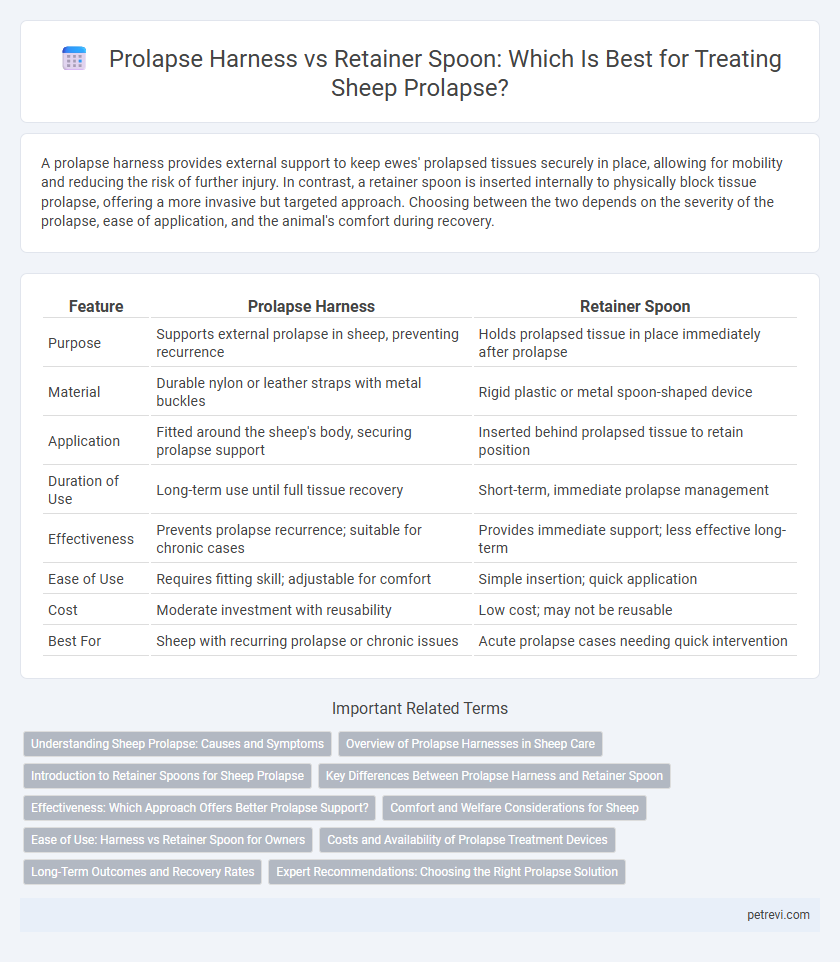A prolapse harness provides external support to keep ewes' prolapsed tissues securely in place, allowing for mobility and reducing the risk of further injury. In contrast, a retainer spoon is inserted internally to physically block tissue prolapse, offering a more invasive but targeted approach. Choosing between the two depends on the severity of the prolapse, ease of application, and the animal's comfort during recovery.
Table of Comparison
| Feature | Prolapse Harness | Retainer Spoon |
|---|---|---|
| Purpose | Supports external prolapse in sheep, preventing recurrence | Holds prolapsed tissue in place immediately after prolapse |
| Material | Durable nylon or leather straps with metal buckles | Rigid plastic or metal spoon-shaped device |
| Application | Fitted around the sheep's body, securing prolapse support | Inserted behind prolapsed tissue to retain position |
| Duration of Use | Long-term use until full tissue recovery | Short-term, immediate prolapse management |
| Effectiveness | Prevents prolapse recurrence; suitable for chronic cases | Provides immediate support; less effective long-term |
| Ease of Use | Requires fitting skill; adjustable for comfort | Simple insertion; quick application |
| Cost | Moderate investment with reusability | Low cost; may not be reusable |
| Best For | Sheep with recurring prolapse or chronic issues | Acute prolapse cases needing quick intervention |
Understanding Sheep Prolapse: Causes and Symptoms
Sheep prolapse commonly occurs due to factors like excessive straining during lambing, poor nutrition, or weakened pelvic muscles, leading to vaginal or rectal tissue protrusion. Symptoms include visible tissue outside the vulva or rectum, swelling, redness, and discomfort that can escalate to infection if untreated. Understanding these causes and signs is essential for choosing effective treatments like a prolapse harness or retainer spoon to prevent further injury.
Overview of Prolapse Harnesses in Sheep Care
Prolapse harnesses in sheep care provide a secure, non-invasive method to manage vaginal or uterine prolapse by supporting the pelvic area and preventing recurrence. These devices typically feature adjustable straps and a strong framework to redistribute pressure evenly around the sheep's body, enhancing comfort and mobility during recovery. Compared to retainer spoons, prolapse harnesses reduce the risk of tissue damage and are often preferred for long-term stabilization in flock health management.
Introduction to Retainer Spoons for Sheep Prolapse
Retainer spoons are specifically designed devices used to treat vaginal or uterine prolapse in sheep by providing gentle support and preventing further protrusion. Made from durable, adjustable materials, retainer spoons ensure comfort and reduce injury risk during recovery compared to traditional methods like harnesses. Veterinary professionals often prefer retainer spoons due to their effectiveness in maintaining prolapse reduction and promoting quicker healing.
Key Differences Between Prolapse Harness and Retainer Spoon
The prolapse harness provides external support by securely holding the prolapsed tissue in place, making it ideal for temporary stabilization in sheep. In contrast, the retainer spoon is inserted internally to physically retain the prolapsed organs, offering a more direct and sometimes longer-term solution. Key differences include the harness's non-invasive application versus the spoon's internal placement, with each method varying in comfort, ease of use, and suitability depending on the severity of the prolapse.
Effectiveness: Which Approach Offers Better Prolapse Support?
A prolapse harness provides consistent external support, reducing the risk of recurrence in sheep prolapse cases by evenly distributing pressure around the tail and anus area. In contrast, a retainer spoon offers internal support by securing the prolapsed tissue back into place, which can be effective for short-term stabilization but may require frequent adjustment. Studies indicate that prolapse harnesses generally offer better long-term support and improved healing outcomes due to their durable design and ease of application.
Comfort and Welfare Considerations for Sheep
The prolapse harness offers adjustable support that maintains the sheep's natural posture, promoting greater comfort and reducing stress during recovery compared to the retainer spoon. Designed to evenly distribute pressure around the tail and hindquarters, the harness minimizes the risk of chafing and tissue damage, enhancing overall welfare. In contrast, the retainer spoon, while effective in retaining prolapse, may cause localized discomfort and restrict movement, potentially impacting the sheep's behavior and recovery experience.
Ease of Use: Harness vs Retainer Spoon for Owners
Prolapse harnesses offer greater ease of use for sheep owners due to their adjustable straps and secure fit, allowing quick application and minimal handling stress. Retainer spoons require more precision and practice to insert correctly, making them less user-friendly for inexperienced owners. Harnesses generally provide consistent support with less maintenance, improving overall management during prolapse treatment.
Costs and Availability of Prolapse Treatment Devices
Prolapse harnesses are generally more cost-effective and widely available through agricultural supply stores and veterinary providers, making them a practical choice for sheep farmers seeking immediate treatment options. Retainer spoons, while sometimes preferred for their specific design advantages, tend to be more expensive and less commonly stocked, often requiring special ordering from specialized livestock equipment suppliers. Cost efficiency and ease of access to prolapse harnesses contribute to their popularity in managing sheep prolapse cases on commercial farms.
Long-Term Outcomes and Recovery Rates
Prolapse harnesses provide superior long-term outcomes for sheep prolapse treatment by offering stable support that minimizes tissue damage and reduces recurrence rates compared to retainer spoons. Studies indicate harnesses promote faster recovery times and lower complication incidences, enhancing overall animal welfare. Retainer spoons may be effective for short-term management but often lead to higher relapse and slower healing in chronic cases.
Expert Recommendations: Choosing the Right Prolapse Solution
Experts recommend selecting a prolapse harness for sheep with severe or recurring prolapses due to its superior support and durability, while a retainer spoon is preferred for mild cases requiring less invasive intervention. Veterinary guidelines emphasize the harness's ability to maintain proper positioning during movement, reducing the risk of reoccurrence and tissue damage. Effective prolapse management combines timely application of the harness or spoon with additional medical treatment tailored to the sheep's condition and environment.
Prolapse Harness vs Retainer Spoon for Sheep Prolapse Treatment Infographic

 petrevi.com
petrevi.com